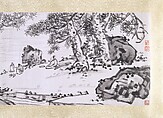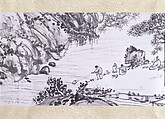Brewing Tea
Wu Changshuo Chinese
Wu Changshuo created a distinctive style that fused the classical epigraphic approach to painting with the popular style of Ren Yi (1840–1895) and continued the literati ideal of uniting poetry, calligraphy, and painting in a single work of art.
Wu's image of a scholar seated beside a qin (zither) savoring freshly brewed tea celebrates the timeless literati ideals of refinement, withdrawal, and self-cultivation. Wu chose a traditional subject and blunt calligraphic brushwork when many artists were turning to the West for subject matter and style, reflecting his belief in the Chinese tradition as an enduring resource for the modern artist. Wu's poem reads:
Watching the bubbling spring water,
Sitting beside the stony edge of the lake,
Old pines resemble ancient sages,
A qin lies by a man from the past.
(Wen Fong, trans., Between Two Cultures: Late-Nineteenth- and Early-Twentieth-Century Chinese Paintings from the Robert H. Ellsworth Collection in The Metropolitan Museum of Art [New York: The Metropolitan Museum of Art, 2001], p. 71)
Due to rights restrictions, this image cannot be enlarged, viewed at full screen, or downloaded.
This artwork is meant to be viewed from right to left. Scroll left to view more.





